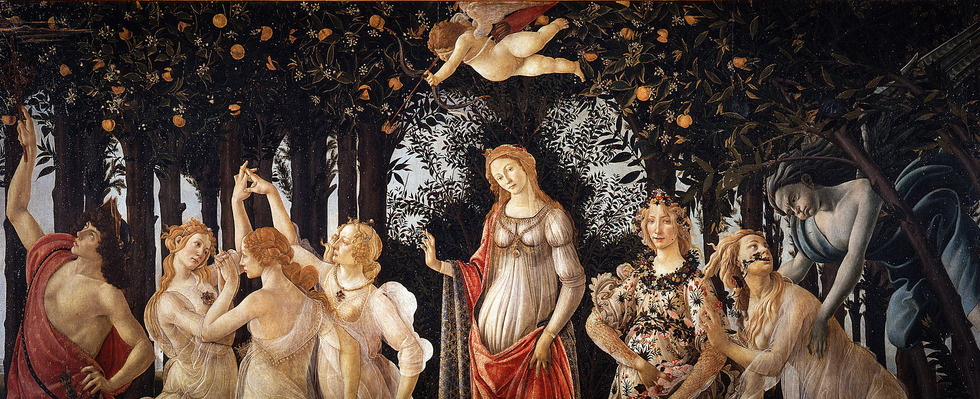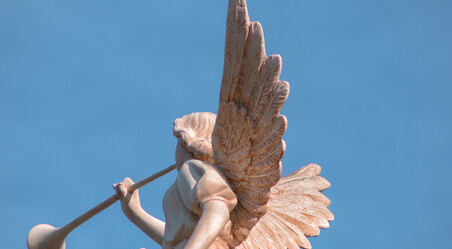The Via Pulchritudinis: Beauty and the New Evangelisation
Dudley Plunkett FAITH MAGAZINE May-June 2013
Dudley Plunkett, senior academic tutor at the Maryvale Institute in Birmingham, offers
a reflection on beauty as a path to God in the light of the New Evangelisation.
While the Church must always continue to develop its exposition of the Faith through theology and apologetics, it should by no means neglect the power of beauty to affect human thinking, feeling and judgement. Indeed, beauty can have its own power to bring people to faith from rational argument. As the Catechism puts it: “Truth can also find other complementary forms of human expression, above all when it is a matter of evoking what is beyond words: the depths of the human heart, the exaltations of the soul, the mystery of God.” (CCC, 2500) While intellectual conclusions can change convictions, something more is needed to bring about a personal relationship with the Lord. There is therefore a link to be made between beauty, seen ultimately as an attribute of God, and the pursuit of theChurch’s evangelising mission. This insight, though commonly cited, including in the Instrumentum Laboris for the 2012 Synod on the new evangelisation, remains however somewhat nebulous. Can believers take hold of it during the Year of Faith in a way that empowers them “to radiate the word of truth that the Lord Jesus has left us” (Benedict XVI, Porta Fidei, 6)?
How Beauty Impinges on our Rational Consciousness and Feelings
Not everyone is consistently aware of beauty, and yet it is always there for those whose minds and hearts are open to it. In the end it is for a person to perceive that they need beauty, that it pleases, satisfies and inspires them. They are made in the image of God and have a soul that is only completely content when it contemplates the beauty which is absolute, in eternity, and which is the reflection, in time, of the God who unites goodness, beauty and truth, most visibly in our earthly existence through Jesus Christ. Ultimately, therefore, our sense of beauty stems from the incarnational faith that God has given us in Christ; now God has a face… and it must be absolutely good, beautiful and true.
From such contemplation we sense a magnetism that characterises beauty. So, whether we are walking through natural scenery, visiting an art gallery, encountering a special personality, participating in a liturgical ceremony, uncovering secrets of the scientific or mathematical world, in all these ways we scarcely realise what has happened until it is there before us and suddenly evident to us with its compelling quality of perfection. We are drawn to it with our intellectual faculties and our emotions. Natural awareness of beauty can vary with our state of preparedness, but we can all recognise peak experiences of beauty that awaken or startle us and remain long in our memories. At first they may be taken merely as aesthetic moments, such as communing with nature, savouring memories andimages, meeting mysteries, the heightened sensing of musical sounds, odours, colours, the thrill of acute poetic expression, or moving encounters with other human beings; but on further reflection people often cite such experiences as having a spiritual quality and as hints of the divine.
Beauty, a Way to God
Although the Church has preserved a tradition as a patron of the arts for more than a millennium, and the great mediaeval cathedrals in particular have portrayed Christianity through their paintings, sculptures, and perhaps especially their windows, Catholic teachers are now refocusing on literary, cultural and artistic beauty as a conscious resource for the transmission of the faith. In his remarkable personal appeal to artists, Pope John Paul II suggested how beauty in the work of artists can be a bridge to the transcendent: “Even beyond its typically religious expressions, true art has a close affinity with the world of faith, so that, even in situations where culture and the Church are far apart, art remains a kind of bridge to religious experience” (John Paul II, Letter to Artists,1999, 10).
More recently, the Pontifical Council for Culture has linked evangelisation and beauty by proposing that “the via pulchritudinis can open the pathway for the search for God” (PCC, The Via Pulchritudinis, Pathway for Evangelisation and Dialogue, 2006). Beauty can evangelise because it has the potential to convince, not by rational argument but through an intuitive or spiritual engagement. Beauty invites to contemplation, and to prayer, as it leads us back to its source. God has created a world which sacramentally reflects and expresses his love, his beauty and the truth about himself.
The Catechism makes clear the interpenetration of these divine attributes: “The practice of goodness is accompanied by spontaneous spiritual joy and moral beauty. Likewise, truth carries with it the joy and splendour of spiritual beauty.
Truth is beautiful in itself” (CCC, 2500). In discovering beauty, therefore, we come closer to God in all his attributes, for we are able “to see through perceptible beauty to eternal beauty” (VP, II.1).
Evangelisation in Need of Renewal
John Paul II introduced the expression the “new evangelisation” early in his pontificate, and returned continually to the theme. It was then taken up by Pope Benedict and the whole Church. By way of a summary of what the term has come to imply after 30 years of use, we can say first that evangelisation has always been the mission of the Church empowered by the presence and activity of the Holy Spirit (John Paul II, Novo Millennio Ineunte, 45). Pope Benedict then took the initiative of creating the Pontifical Council for the Promotion of the New Evangelisation, and made this topic the theme of the 2012 Synod of Bishops as well as an important aspect of the Year of Faith. Because of the “profound crisis of faith” in the world today (PF, 2), the Church is proposing not merely a continuationof the mission ad extra and ad intra but a renewal of the whole concept of evangelisation so that it is addressed through an energetic dialogue with secular cultures.
One project stemming from this idea is the PCC’s Courtyard of the Gentiles, inspired by the Temple in Jerusalem but also redolent of Paul’s Acropolis experience in Acts 17. It involves planned encounters between believers and non-believers of cultural distinction held in various cities, the first at the Unesco building in Paris and subsequent ones in Stockholm and Assisi. However innovative such experiments are, it is clear that, in John Paul II’s words, the “fervour, methods and expression” of evangelisation must continue to be renewed. Until the recent past the main emphasis has been on apologetics, catechesis and other reasoned approaches, but there are complementary steps to be taken towards the expressive and inspirational by featuring less rational and doctrinal means, such assacred art, that can in their distinct manner explore the way of beauty.1
Evangelising Culture and the Way of Beauty
A strongly emerging feature of the new evangelisation that has been consistently emphasised by Popes John Paul and Benedict has been the evangelising of culture through the patrimony of the Church, the talents of artists and the efforts of believers to show the relevance of the Gospel to the world at large. The “evangelising” of culture denotes the general impact of the gospel on human values and ways of being, though it involves many of the same approaches as when individuals are the focus, such as personal witness, proclaiming the Word, apologetics and dialogue, as well as the appeal to emotional and spiritual sensitivities.
The practical challenge faced by those who wish to evangelise contemporary culture through the way of beauty is to envision how it might effectively challenge and transform secular values and ways of understanding. One could turn to many artists for a precedent for a newly evangelised culture comprising imaginative activities that are open to the transcendent, a culture that integrates human creativity in art, literature and science with the call to holiness, to a life that acknowledges truth, goodness and beauty as having their source in the divine. God is the author of beauty that is beyond words, beyond the rational, as the Catechism affirms: “Even before revealing himself to man in words of truth, God reveals himself to him through the universal language of creation, the work of hisWord, of his wisdom; the order and harmony of the cosmos – which both the child and the scientist discover…” (CCC, 2500). We are being encouraged to lift our gaze beyond those aspects of beauty that enchant us in nature, art, science, and also the human person made in the image of God, to perceive the link to the truths of faith and to God.
The Christian believer is being prompted even more directly by the practice of prayer, the experience of worship, the contemplation of the Word of God in Scripture and by so many other epiphanies of God’s glory, to discover the divine source of goodness, truth and beauty. Such insights promise benefits even for our earthly existence. Is it not certain that the spiritual qualities and reflections of the divine to be found in cultures by no means negate human riches of intellect, aesthetics or sensitivity? In fact, are not human cultures enhanced and renewed by their openness to the Spirit, so that just as a spiritually refreshed culture can encourage belief, so those who have found God through such renewal can become open to new aesthetic, scientific and philanthropic inspirations?
Notes:
1For several years the Maryvale Institute has run a successful Art, Beauty and Inspiration course that explores the use of art in understanding the Faith. A similar approach has been employed in recent catechetical courses, such as Anchor and Evangelium, in which religious ideas and understandings are approached initially through paintings rather than verbal explanations.






